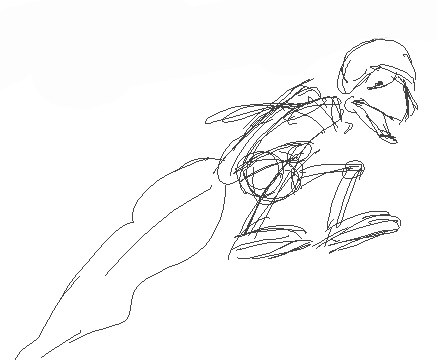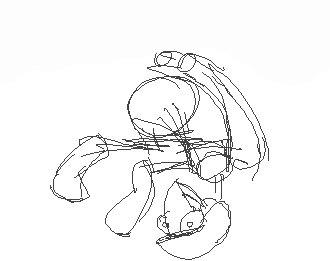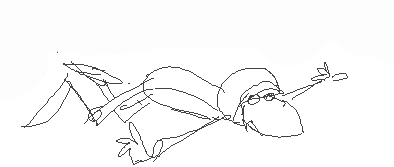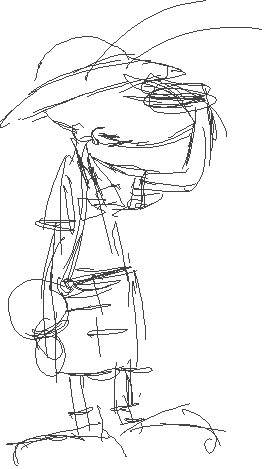Frantically Going From Here to There Slowly
A recent discussion about producing a cartoon series for the web inspired this article.
As creators of cartoons we often have to make lots of decisions about form and format. One basic decision is to whether to produce “one shot” cartoons or to produce a series of related cartoons. Another decision is “if we decide to produce a series of related cartoons are we going to have story arcs or just have the series as a loose collection of adventures for our cast of characters?”
In general we can say that there are three basic elements involved in each episode of a cartoon series. First and foremost there is the primary action of the episode, which if we are talking funny cartoons that means the humor. Next if we are trying to develop a series that will entertain and sustain an audience, we need to have interesting characters with whom the audience will identify or about whom they will at least want to learn more. And finally we may have a longer theme of a storyline which we will want to weave throughout our episodes. Storylines can be serial in nature as in a story arc or they can just be more contextual as in a series of miscellaneous adventures. Classic cartoon series examples like Rocky and Bullwinkle were highly serialized while Dexter’s Laboratory was just miscellaneous adventures. You could even do a mixture.

Another important decision has to do with the length of our episodes. If we are producing for a regulated distribution medium like television than there are restrictions that tend to dictate the desired length of an episode. Theatrical cartoons were historically 6 - 7 minutes long. TV cartoons followed that format as it seemed to fit the standard 30 minute time slot with its important commercial breaks. Some TV cartoons were shortened to 5 minutes and extra space was filled with short entertaining “bumpers”. Breaking a cartoon up with commercials in the middle is usually not desirable although South Park and The Simpsons are notable exceptions.

For web production, cartoons tend to be shorter for several reasons. Bandwidth limitations make shorter productions more attractive. Also, web audiences are notoriously short on patience and their attention spans are shorter so it is usually better to be brief. Also in the competitively noisy world of the Internet, frequency and regularity of content production is a benefit as it helps to keep your work fresh and constantly in front of your target audience. So fast turn around dictates the need for short production cycles and therefore it is easier to produce shorter episodes more often. Ideally a one minute to a minute and a half long episode is the maximum desired. This of course limits what can be accomplished in a single episode. Gags require time to be set up and to be delivered so that has to be the major focus and then characterization takes the next most important consideration with storytelling in third place. This by its nature means that web cartoon stories develop slower and take more episodes to tell then if they were TV based episodes. Now don’t confuse the slow pace of story development with slow moving cartoons. The pace of the individual episodes can be varied and frantic with lots of energy, you just can’t advance the storyline too much in any one episode.

In creating animated content we think a great deal about timing. We focus on the timing of individual movements and actions and the rhythm and pacing of the episode itself. So now we have an additional consideration which is the rhythm and pacing of our episode to episode storytelling. Now just like the rhythm and pacing within an episode you want to vary your story exposition rhythm and pacing. Some episodes will advance the story more than others and some episodes will create more questions than answers. And some episodes will not move the story forward at all. So now you have a whole new area of control in your cartoon planning. Just ask yourself, these questions as you write each new episode. (1) Is this really as funny as it could be? (2) Am I letting the audience get to know the characters? (3) Am I letting story telling push things too much? And (4) how does this episode fit my desired rhythm and pacing for story exposition?

As creators of cartoons we often have to make lots of decisions about form and format. One basic decision is to whether to produce “one shot” cartoons or to produce a series of related cartoons. Another decision is “if we decide to produce a series of related cartoons are we going to have story arcs or just have the series as a loose collection of adventures for our cast of characters?”
In general we can say that there are three basic elements involved in each episode of a cartoon series. First and foremost there is the primary action of the episode, which if we are talking funny cartoons that means the humor. Next if we are trying to develop a series that will entertain and sustain an audience, we need to have interesting characters with whom the audience will identify or about whom they will at least want to learn more. And finally we may have a longer theme of a storyline which we will want to weave throughout our episodes. Storylines can be serial in nature as in a story arc or they can just be more contextual as in a series of miscellaneous adventures. Classic cartoon series examples like Rocky and Bullwinkle were highly serialized while Dexter’s Laboratory was just miscellaneous adventures. You could even do a mixture.

Another important decision has to do with the length of our episodes. If we are producing for a regulated distribution medium like television than there are restrictions that tend to dictate the desired length of an episode. Theatrical cartoons were historically 6 - 7 minutes long. TV cartoons followed that format as it seemed to fit the standard 30 minute time slot with its important commercial breaks. Some TV cartoons were shortened to 5 minutes and extra space was filled with short entertaining “bumpers”. Breaking a cartoon up with commercials in the middle is usually not desirable although South Park and The Simpsons are notable exceptions.

For web production, cartoons tend to be shorter for several reasons. Bandwidth limitations make shorter productions more attractive. Also, web audiences are notoriously short on patience and their attention spans are shorter so it is usually better to be brief. Also in the competitively noisy world of the Internet, frequency and regularity of content production is a benefit as it helps to keep your work fresh and constantly in front of your target audience. So fast turn around dictates the need for short production cycles and therefore it is easier to produce shorter episodes more often. Ideally a one minute to a minute and a half long episode is the maximum desired. This of course limits what can be accomplished in a single episode. Gags require time to be set up and to be delivered so that has to be the major focus and then characterization takes the next most important consideration with storytelling in third place. This by its nature means that web cartoon stories develop slower and take more episodes to tell then if they were TV based episodes. Now don’t confuse the slow pace of story development with slow moving cartoons. The pace of the individual episodes can be varied and frantic with lots of energy, you just can’t advance the storyline too much in any one episode.

In creating animated content we think a great deal about timing. We focus on the timing of individual movements and actions and the rhythm and pacing of the episode itself. So now we have an additional consideration which is the rhythm and pacing of our episode to episode storytelling. Now just like the rhythm and pacing within an episode you want to vary your story exposition rhythm and pacing. Some episodes will advance the story more than others and some episodes will create more questions than answers. And some episodes will not move the story forward at all. So now you have a whole new area of control in your cartoon planning. Just ask yourself, these questions as you write each new episode. (1) Is this really as funny as it could be? (2) Am I letting the audience get to know the characters? (3) Am I letting story telling push things too much? And (4) how does this episode fit my desired rhythm and pacing for story exposition?


0 Comments:
Post a Comment
<< Home